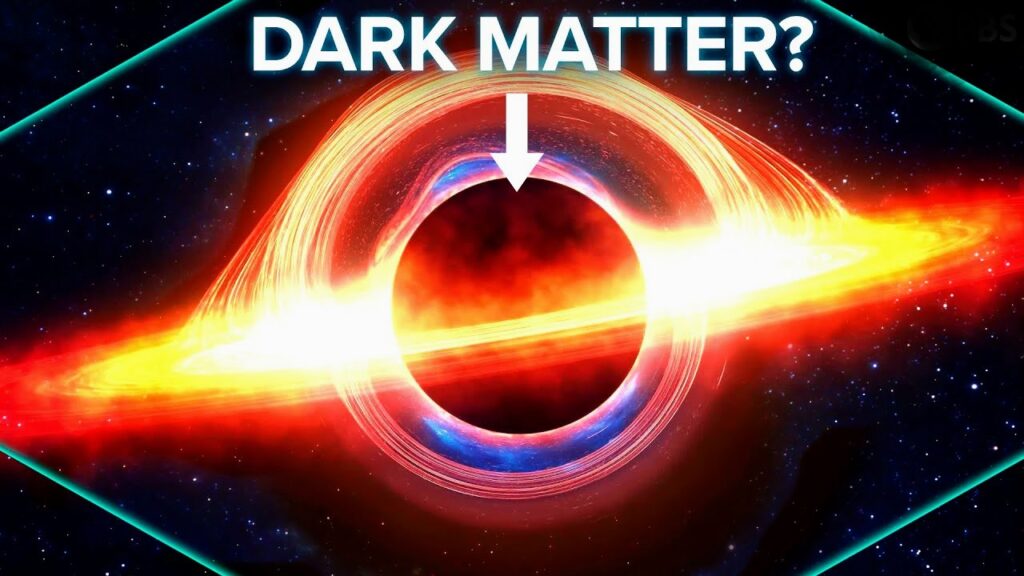
Hello friends Dark matter is a hypothetical form of matter that is believed to make up approximately 27% of the universe’s mass and energy. It does not emit, absorb, or reflect light, making it invisible and undetectable by electromagnetic radiation.
Despite its elusive nature, scientists infer the existence of dark matter through its gravitational effects on visible matter, such as galaxies and galaxy clusters.
Key points about dark matter include:

1. Gravitational Effects: Dark matter is postulated to exist because the gravitational effects observed in the universe cannot be explained by the visible matter alone. Galaxies rotate, and galaxy clusters hold together in ways that suggest the presence of more mass than can be accounted for by observable matter.
2. Composition: The nature of dark matter remains unknown. It is not composed of the same particles as ordinary matter (protons, neutrons, and electrons) that make up stars, planets, and living organisms. Leading candidates for dark matter include weakly interacting massive particles (WIMPs) and axions.
3. Interaction with Light: Dark matter does not interact with light or other forms of electromagnetic radiation, making it challenging to detect directly. It neither emits nor absorbs photons, which are particles of light.

4. Large-Scale Structure Formation: Dark matter is thought to have played a crucial role in the formation of large-scale structures in the universe, such as galaxies and galaxy clusters. Its gravitational influence helped pull matter together to form these structures.
5. Dark Matter Halos: Galaxies are believed to be embedded within massive halos of dark matter. These halos extend beyond the visible boundaries of galaxies and contribute significantly to the total mass of a galaxy.
6. Cosmic Microwave Background (CMB): The cosmic microwave background radiation, a remnant of the early universe, provides additional evidence for the existence of dark matter. Patterns in the CMB are consistent with the gravitational effects of dark matter.
Efforts to directly detect dark matter particles are ongoing, with experiments conducted deep underground to shield from cosmic rays and other background radiation. While indirect evidence strongly supports the existence of dark matter, its exact nature remains one of the most significant mysteries in modern astrophysics and cosmology. The study of dark matter is a crucial aspect of understanding the large-scale structure and evolution of the universe.
1. Gravitational Effects:
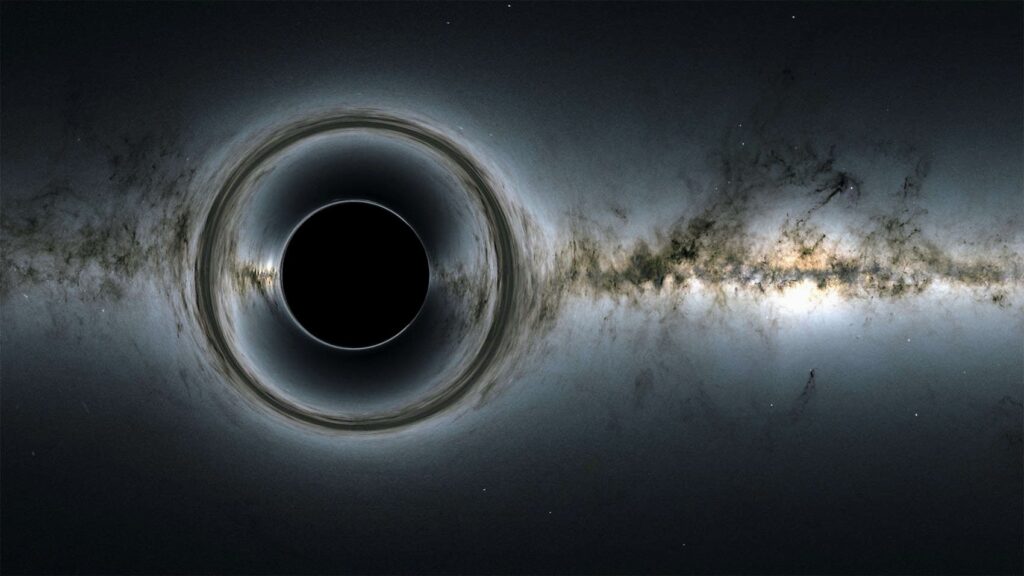
Gravitational effects are observable phenomena that result from the gravitational force exerted by masses in the universe. These effects play a crucial role in shaping the structure and behavior of celestial objects and systems. Here are some key gravitational effects:
1. Orbital Motion:
•Gravitational forces govern the motion of objects in space, such as planets orbiting the Sun or moons orbiting planets. The gravitational attraction between these objects and the central body determines their orbits.
2. Tidal Forces:
•Tidal force arises due to gravitational interaction between celestial bodies. For example, the Moon’s gravitational pull causes tides on Earth, leading to the rise and fall of ocean levels.
3. Formation of Celestial Bodies:
•Gravitational collapse is responsible for the formation of celestial bodies, including stars, planets, and galaxies. A cloud of gas and dust collapses under its self-gravity, leading to the formation of a new celestial object.
4. Gravitational Lensing:
•Massive objects, such as galaxies or galaxy clusters, can bend the path of light that passes near them due to their gravitational field. This phenomenon, known as gravitational lensing, can be used to study distant objects and provides evidence for the presence of dark matter.
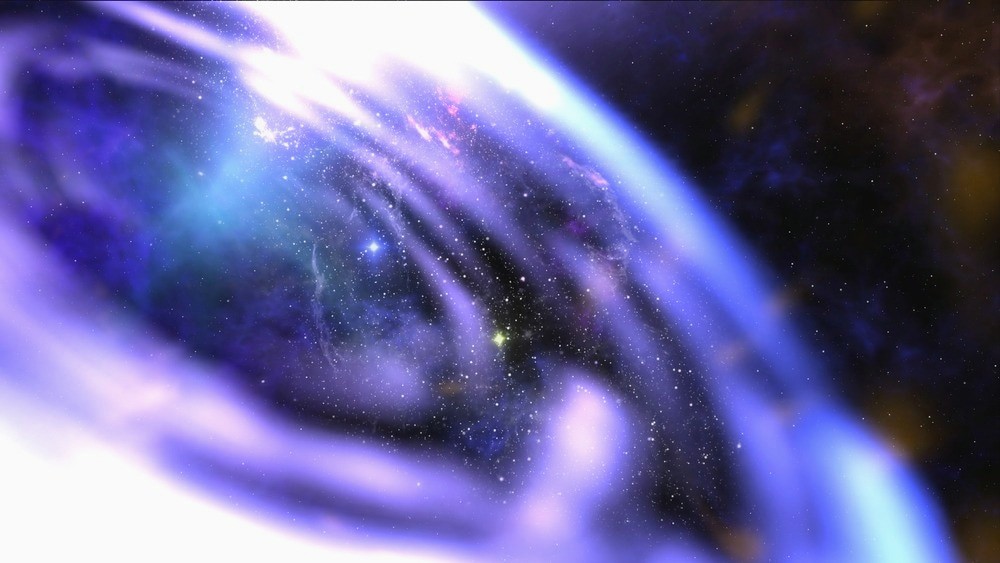
5. Galactic Rotation Curves:
•The rotation curves of galaxies, or the way in which the orbital speeds of stars within a galaxy change with their distance from the galactic center, are influenced by the distribution of mass in the galaxy. Deviations from the expected rotation curves indicate the presence of unseen mass, often attributed to dark matter.
6. Cosmic Large-Scale Structure:
•The distribution of galaxies and galaxy clusters on the largest scales in the universe is influenced by gravitational interactions. Over time, gravity causes matter to clump together, forming structures such as galaxy clusters and superclusters.
7. Gravitational Redshift:
•Light from distant objects can be redshifted (its wavelength stretched) due to the gravitational field it passes through. This effect, known as gravitational redshift, is a consequence of general relativity and has been observed in the light from massive objects like stars.

8. Black Holes:
•The extreme gravitational field near a black hole is so intense that nothing, not even light, can escape from it beyond a certain point called the event horizon. This is a direct consequence of the strength of the gravitational force near massive objects.
Gravitational effects are a fundamental aspect of the universe and are described by Albert Einstein’s theory of general relativity. This theory provides a comprehensive framework for understanding gravity as the curvature of spacetime caused by the presence of mass and energy.
Observing and studying gravitational effects is essential for advancing our understanding of the cosmos and the fundamental forces that shape it.
2. Composition:
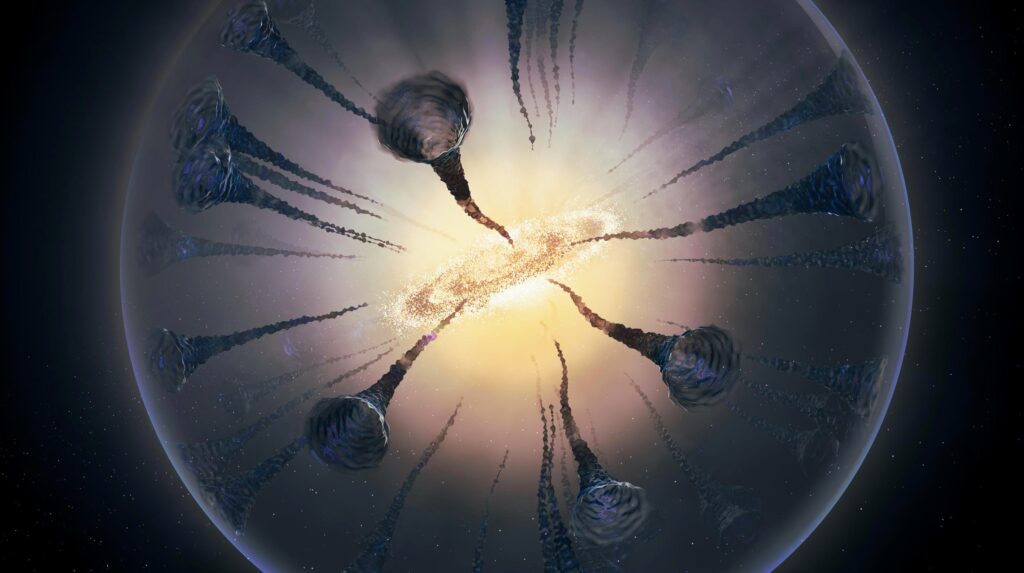
The term “composition” can have different meanings depending on the context. It can refer to the makeup or elements of something. Here are a few contexts in which the term “composition” is commonly used:
1. Chemical Composition:
•In the context of chemistry, the chemical composition of a substance refers to the types and proportions of chemical elements that make up that substance. For example, the chemical composition of water is two hydrogen atoms and one oxygen atom, expressed as H₂O.
2. Musical Composition:
•In music, a composition is a piece of music created through the arrangement of musical elements such as melody, harmony, rhythm, and dynamics. Compositions can range from simple songs to complex symphonies.
3. Written Composition:
•In literature and writing, a composition refers to a written work, such as an essay, article, or poem. The composition is the structure and arrangement of words to convey ideas or emotions.
4. Photographic Composition:
•In photography, composition means placing the composition systematically within its frame. This includes considerations such as framing, balance, and the use of lines and colors to create a visually appealing image.

5. Artistic Composition:
•In visual arts, composition involves the arrangement of elements within a work of art. This can include considerations of balance, proportion, and the overall design of the piece.
6. Geological Composition:
•In geology, the composition of rocks or soils refers to the types and proportions of minerals or organic materials present. This information helps geologists understand the origin and properties of geological formations.
7. Astronomical Composition:
•In astronomy, the composition of celestial bodies (such as stars, planets, and asteroids) refers to the elements and compounds present. Spectroscopy is often used to analyze the composition of distant objects in the universe.
8. Photonic Composition:
•In optics and photonics, the composition of materials can refer to their optical properties, such as the refractive index, which describes how light propagates through the material.
These are just a few examples, and the term “composition” can be used in various fields to describe the structure, arrangement, or makeup of different things. If you have a specific context in mind, feel free to provide more details for a more targeted explanation.
3. Interaction with Light:

When we discuss the interaction of a substance with light, we are often referring to how the material responds to electromagnetic radiation, including visible light.
The interaction of a material with light is influenced by its optical properties, and these interactions can vary depending on the nature of the material. Here are some common ways in which materials can interact with light:
1. Transparency:
•Transparent materials allow light to pass through them without significant scattering or absorption. Materials like glass and clear plastics are examples of transparent substances. When light passes through them, it is not significantly altered, and objects on the other side can be seen clearly.
2. Translucency:
•Or some types of translucent material allow light to pass through but also diffuse and scatter light. This results in a degree of opacity, making it difficult to see objects on the other side with clarity. Frosted glass or certain types of paper are examples of translucent materials.
3. Opacity:
•Opaque materials do not allow light to pass through; instead, they absorb or reflect it. These materials block the transmission of light and create shadows. Metals and wood are common examples of opaque materials.
4. Reflection:
•Reflection occurs when light bounces off the surface of a material. Smooth, polished surfaces tend to produce regular reflection, where the angle of incidence equals the angle of reflection. Mirrors exemplify materials that exhibit high reflectivity.

5. Refraction:
•Refraction is the bending of light and its passing from one medium to another with different optical density. This bending of light can lead to phenomena such as the apparent shift in the position of objects when viewed through a transparent medium like water or glass.
6. Absorption:
•Absorption involves the transfer of light energy to the atoms or molecules within a material, leading to an increase in internal energy. Different materials absorb light at different wavelengths, and this absorption can affect the material’s color.
7. Scattering:
•Scattering occurs when light interacts with small particles or irregularities in a material, causing the light to change direction. The sky appears blue during the day due to Rayleigh scattering, where shorter wavelengths of light are scattered more than longer wavelengths.
8. Fluorescence and Phosphorescence:
•Some materials can absorb light at one wavelength and reemit it at a longer wavelength. This phenomenon is known as fluorescence. Phosphorescence is similar but involves delayed emission. Certain substances, like certain types of minerals, exhibit these properties.
The interaction of materials with light is a fundamental aspect of optics and plays a crucial role in various fields, including physics, materials science, and engineering. Understanding how different materials interact with light is essential for designing optical devices, studying the properties of materials, and creating visual arts, among other applications.
4. Large-Scale Structure Formation:
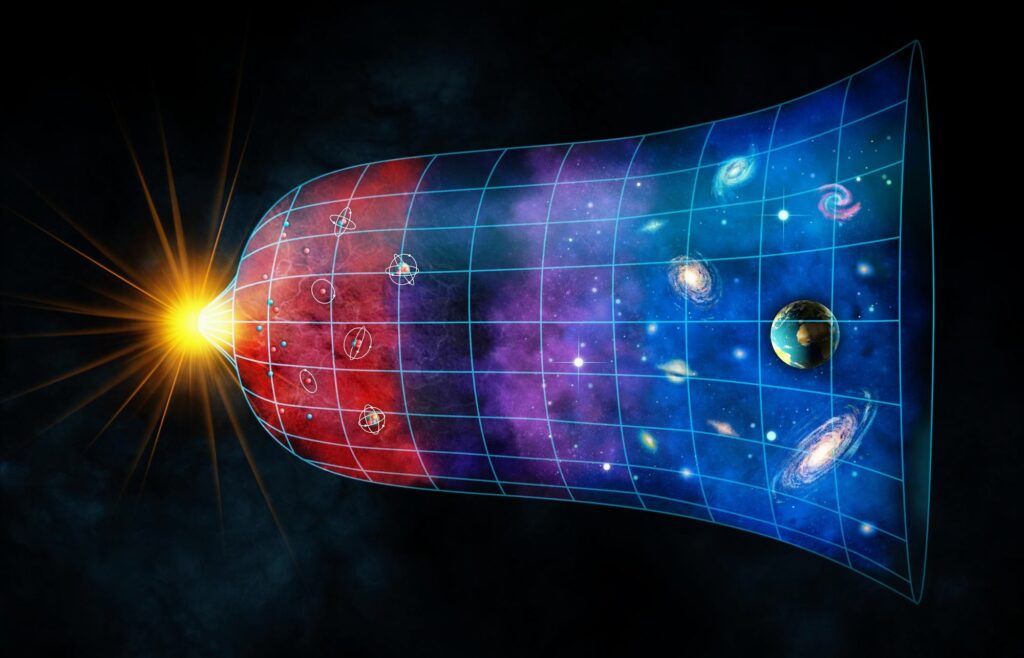
Large-scale structure formation refers to the process by which the vast cosmic structures, such as galaxy clusters, filaments, and voids, have evolved and organized on the largest scales in the universe. This phenomenon is a key aspect of cosmology and is influenced by the distribution of matter and the effects of gravity over cosmic distances. Here are the main components and processes involved in the formation of large-scale structures in the universe:
1. Cosmic Inflation:
•The process of large-scale structure formation begins shortly after the Big Bang. During the early moments of the universe, a period of rapid expansion known as cosmic inflation is believed to have occurred. Inflationary theory helps explain the observed uniformity and large-scale homogeneity of the cosmos.
2. Formation of Primordial Density Perturbations:
•Quantum fluctuations during the inflationary epoch led to the creation of tiny density variations, or perturbations, in the distribution of matter. These density perturbations provided the initial seeds for the formation of cosmic structures.
3. Dark Matter and Baryonic Matter:
•Dark matter, which does not interact with electromagnetic radiation, and baryonic matter (ordinary matter) make up the cosmic mass density. The gravitational attraction between these forms of matter acts as the driving force for structure formation.
4. Gravitational Instabilities:
•As the universe expands, regions with slightly higher density of matter exert a stronger gravitational pull. Over time, gravitational instabilities cause matter to clump together, forming structures on various scales.
5. Formation of Protogalactic Clouds:
•The initial stages of large-scale structure formation involve the aggregation of matter into protogalactic clouds. These clouds are denser regions where galaxies will eventually form.

6. Galaxy Formation:
•Within protogalactic clouds, smaller structures collapse under gravity to form galaxies. These galaxies, composed of stars, gas, and dark matter, are the building blocks of larger structures.
7. Filaments and Voids:
•Galaxies are not distributed uniformly; instead, they are organized into filamentary structures that connect massive galaxy clusters. Voids, regions with relatively low galaxy density, also exist. Together, filaments and voids create the cosmic web, a large-scale structure of interconnected strands.
8. Galaxy Clusters:
•Over time, these filaments merge to form massive structures known as galaxy clusters. Galaxy clusters are among the most massive gravitationally bound structures in the universe.
9. Observational Evidence:
•Observations of the large-scale structure of the universe, including galaxy surveys and measurements of the cosmic microwave background radiation, provide crucial evidence supporting the theoretical framework of structure formation.
Understanding the formation of large-scale structures is essential for developing models of cosmology and unraveling the mysteries of the universe’s evolution. Simulations, observational studies, and theoretical advancements in astrophysics contribute to our knowledge of these complex processes.
5. Dark Matter Halos:

Dark matter halos are large, diffuse structures that are thought to envelop and surround galaxies, including our own Milky Way. These halos are a key component of the current understanding of the distribution of dark matter in the universe.
While dark matter itself is invisible and does not emit, absorb, or reflect light, its presence is inferred through its gravitational effects on visible matter, such as stars and gas.
Here are some key features of dark matter halos:
1. Composition:
•Dark matter halos are primarily composed of dark matter. The exact nature of dark matter remains unknown, but it is believed to consist of as-yet-undiscovered particles that do not interact with electromagnetic radiation.

2. Size and Extent:
•Dark matter halos are thought to extend well beyond the visible boundaries of galaxies. While the luminous part of a galaxy, such as the stars, might have a well-defined edge, the gravitational influence of dark matter is expected to extend much farther into space.
3. Gravitational Influence:
•The presence of dark matter halos is inferred through their gravitational effects on visible matter. The gravitational pull of the dark matter halo contributes to the rotation curves of galaxies, affecting the speeds of stars in the outer regions.
4. Galactic Rotation Curves:
•Dark matter halos play a crucial role in explaining the observed rotation curves of galaxies. In many cases, the rotation curves do not match the expected distribution of visible matter. The presence of an extended halo of dark matter helps account for the observed velocities of stars at different distances from the galactic center.

5. Galactic Stability:
•Dark matter halos are thought to provide stability to galaxies. Without the gravitational influence of dark matter, galaxies might not have sufficient mass to account for the observed motions of stars within them, and they might be more susceptible to disruptions from interactions with other galaxies.
6. Cosmic Web and Large-Scale Structure:
•Dark matter halos are also interconnected through large-scale structures known as the cosmic web. Filaments of dark matter connect massive galaxy clusters, creating a vast network of interconnected structures on a cosmic scale.

7. Difficult to Detect Directly:
•Dark matter halos are challenging to detect directly because dark matter does not emit, absorb, or reflect light. Scientists infer their existence through observations of gravitational effects and simulations of the large-scale structure of the universe.
8. Role in Galaxy Formation:
•Dark matter halos are believed to have played a crucial role in the formation of galaxies. As baryonic matter (ordinary matter) falls into the gravitational potential well of dark matter halos, it can cool and condense, eventually leading to the formation of stars and galaxies.
The study of dark matter halos is an active area of research in astrophysics and cosmology, and ongoing observations, simulations, and theoretical work aim to deepen our understanding of the Dark matter plays a very important role in the structure and evolution of the universe.
6. Cosmic Microwave Background (CMB):
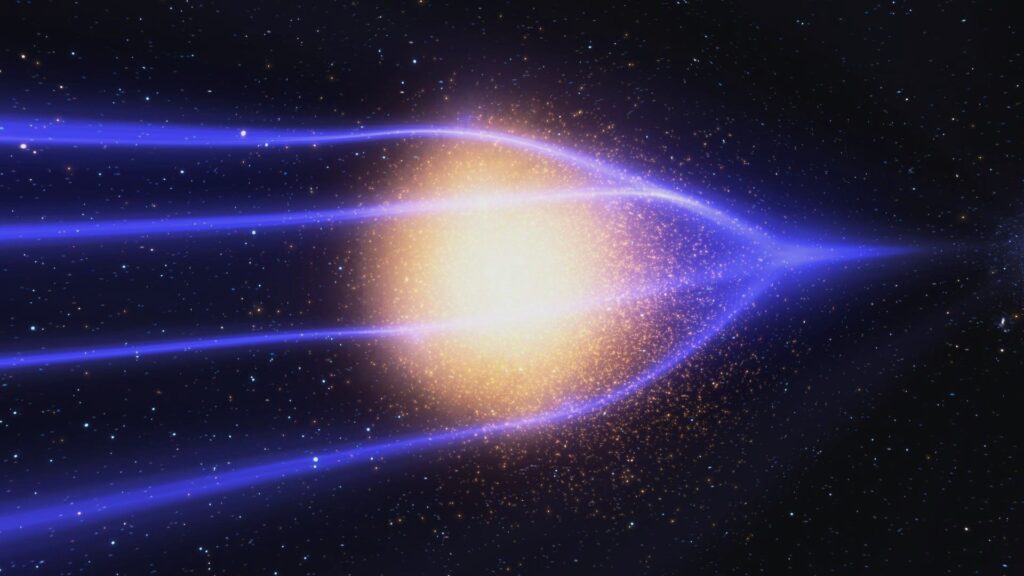
The Cosmic Microwave Background (CMB) is the faint glow of radiation that fills the universe and is observed in the microwave portion of the electromagnetic spectrum. It is a crucial piece of evidence supporting the Big Bang theory and provides valuable insights into the early universe. Here are key features and aspects of the Cosmic Microwave Background:
1. Discovery:
•The CMB was accidentally discovered in 1964 by astronomers Arno Penzias and Robert Wilson at the Bell Telephone Laboratories. They detected a constant, uniform signal of microwave radiation coming from all directions in the sky.
2. Origin:
•The CMB originated when the universe was about 380,000 years old, during a phase known as recombination. Before recombination, the universe was so hot and dense that atoms couldn’t form. As it expanded and cooled, protons and electrons combined to form neutral hydrogen atoms, allowing photons to travel freely.

3. Decoupling:
•Recombination is often referred to as the “decoupling” of matter and radiation. Before this event, photons were scattered by charged particles (free electrons and protons), making the universe opaque. After recombination, photons could travel freely through space, leading to the release of the CMB.
4. Uniformity and Isotropy:
•One of the remarkable features of the CMB is its remarkable uniformity and isotropy. Regardless of the direction in which astronomers look, the CMB appears nearly the same in terms of temperature. This uniformity is consistent with the idea that the early universe was homogeneous and isotropic.
5. Temperature Anisotropies:
•While the CMB is remarkably uniform, there are tiny temperature fluctuations (anisotropies) at the level of one part in 100,000. These fluctuations are believed to be the seeds of structure formation in the universe, giving rise to galaxies, galaxy clusters, and cosmic large-scale structures.
6. Observational Measurements:
•Precise measurements of the CMB have been made by satellite missions such as the Cosmic Background Explorer (COBE), the Wilkinson Microwave Anisotropy Probe (WMAP), and the Planck satellite. These missions have provided detailed maps of the CMB temperature fluctuations, enabling scientists to study the early universe’s conditions.

7. Age of the Universe:
•By studying the CMB, scientists have been able to determine the age of the universe. The most recent measurements, including those from the Planck satellite, estimate the age to be approximately 13.8 billion years.
8. Composition of the Universe:
•The CMB has been crucial in determining the composition of the universe. The observed temperature fluctuations in the CMB are consistent with a universe composed of approximately 5% ordinary matter, 27% dark matter, and 68% dark energy.
9. Polarization:
•In addition to temperature fluctuations, the polarization of the CMB is also studied. Polarization patterns provide information about the early universe’s conditions and the effects of gravitational interactions on CMB photons.
The Cosmic Microwave Background has become a cornerstone of modern cosmology, providing a snapshot of the universe’s early conditions and helping to refine our understanding of its composition, evolution, and large-scale structure.
Conclusion:

In conclusion, our exploration has touched upon various fascinating aspects of the universe, from the elusive nature of dark matter to the expansive structures formed in the cosmos.
The air conditioner installation guide, a journey into the gravitational effects shaping celestial bodies, and the intricate composition of materials interacting with light have all added layers to our understanding.
We delved into the mysterious realm of dark matter, an invisible force shaping the large-scale structure of the universe. Dark matter halos, vast and unseen, play a crucial role in providing stability to galaxies and contributing to the cosmic web that connects celestial structures.

On a smaller scale, we explored the composition of materials and how they interact with light, from transparency and reflection to fluorescence and absorption. Understanding these interactions is fundamental to various fields, from optics and photography to the arts.
The journey continued with the formation of large-scale structures in the universe. Cosmic inflation, primordial density perturbations, and the gravitational dance of dark matter and visible matter all contribute to the cosmic tapestry of galaxies, clusters, and filaments.
The expedition concluded by gazing at the afterglow of the Big Bang—the Cosmic Microwave Background. This faint glow, discovered accidentally, holds the secrets of the early universe, providing evidence for the Big Bang theory, revealing temperature fluctuations that seeded cosmic structures, and painting a picture of a universe approximately 13.8 billion years old.
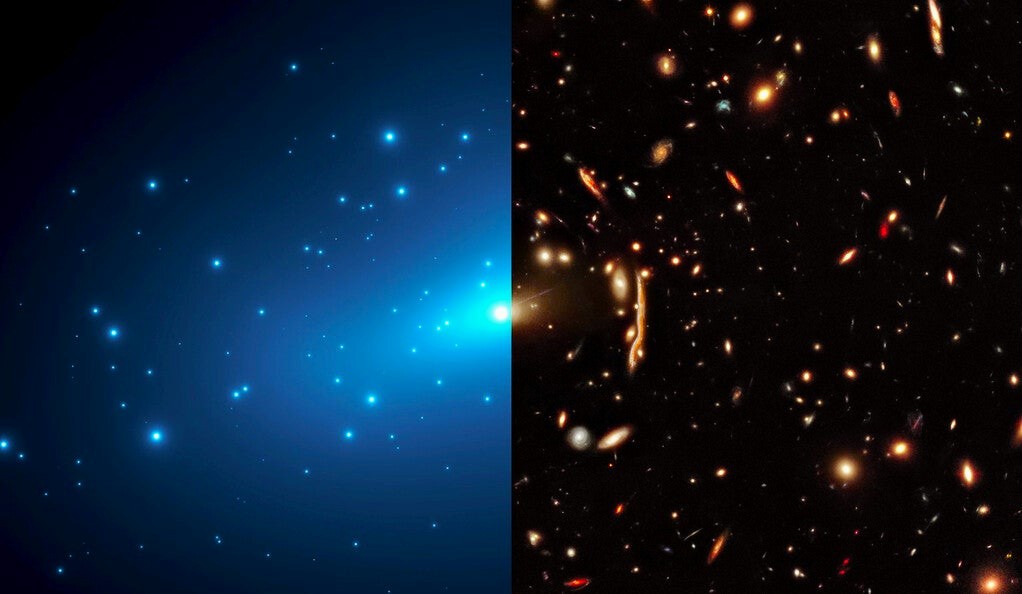
As we conclude, the universe remains an awe-inspiring canvas of mysteries and revelations. From the microscopic interactions of particles to the grand tapestry of cosmic structures, the pursuit of knowledge continues, pushing the boundaries of our understanding and inviting us to explore the wonders of the cosmos.
I hope that you all would have liked reading the information about this knowledge given by me, to get all the information related to many government schemes, government jobs and government news, you must join our WhatsApp and Telegram group. Along with this, do not forget to follow our channel.